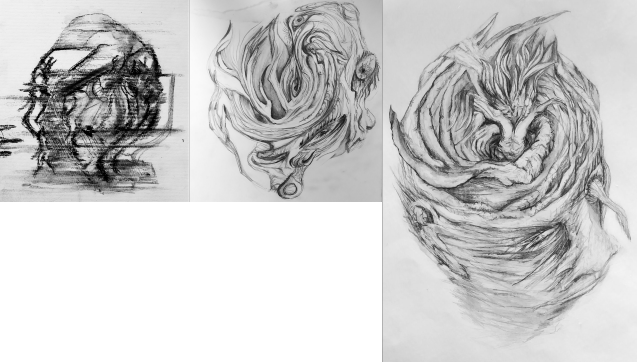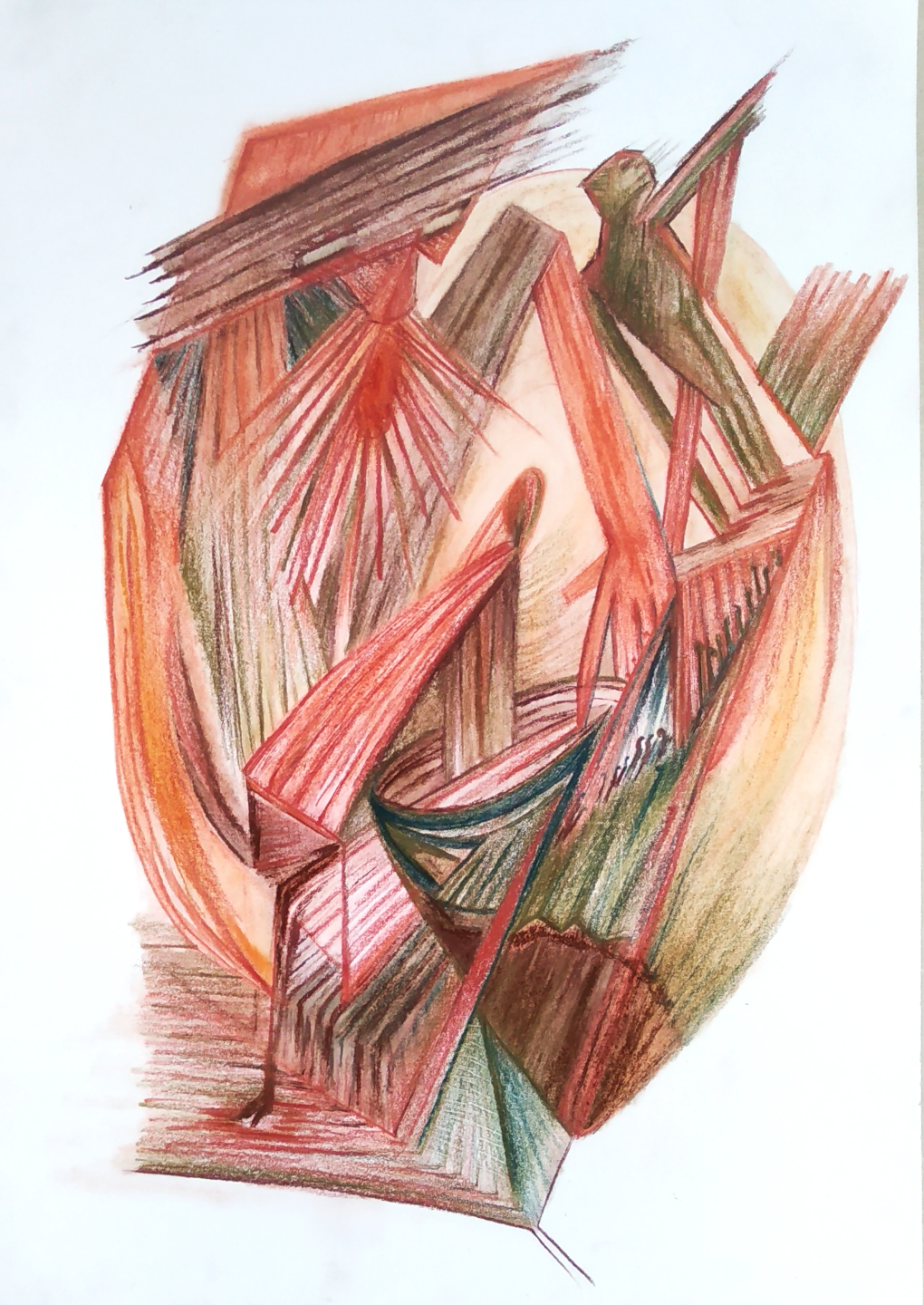Špela Jensterle
SEEING ← → THINKING
“Seeing and thinking” processes are operating hand in hand all the time. It is hard to untangle them into two separate elements.
Humans have a necessity to make meaning out of visual stimuli and also what and how we think affects the way we see.
In one of my approaches for the creation of visual art, I am exploring and exploiting this interconnectedness of seeing on thinking and thinking on seeing.
Which of them is forming/conducting the other? Can this role even be defined or are they constantly acting simultaneously?
In the attempt to define them, I observe which process is the initiator. If there is no predefined concept in an artist's mind, random visual stimuli is the one that begins the narrative. If the concept is deliberately chosen, the freeflow practice is initiated by thinking that consequently influences forms and patterns.
When thinking is the one that initiates seeing, art can be considered as a tool for contemplating on concepts that are usually concerning the phenomenon of the human psyche and human experience in this world, consequently producing depictions of these same concepts that are contemplated on during the practice itself.
The goal is to have a final product, a visual representation of the practitioner’s thought process revolving around a specific concept, or a visual representation that captures the narrative of thought.
First time I was paying attention to this interconnectedness was during the freeflow practice of 3D sculpting. Observing the objects transform, deform, morph and interact with each other instantaneously in the software interface was inevitably forming/triggering thoughts and emotions.
Internal narrative is initiated by abstract or representational objects. In this case seeing is prevalent, influencing and forming thinking, not the other way around.
Freeflow practice with 3D objects is limiting the thought process when aiming for instant final product of animation. Objects require predefined physical properties with clean and correct geometry that serves particular deformations render correctly.
That’s why I started to explore this practice in an analog way using graphite, charcoal and chalk in the spring of 2020. These tools allow me to create products instantly, capturing visual traces of the spontaneous thought process or a depiction of a narrative around a defined concept, while simultaneously conducting their progression through the practice of drawing.
The practice can be adapted on many levels and variations are affecting the outcome. The adaptations of the environment, mental and physical preparations before the practice, the experience of the process and the process of drawing itself are all equally important in defining the final product.
PREPARATION:
Having control over external and internal factors that are impacting one's experience, attention span and the amount of focus during the practice are increased.
Altering set and setting
set: The practitioner's mind can be altered by various physical and psychical efforts prior to or during the process.
My practice involves one or multiple of the following: expressive dance, drumming, experimenting with my voice (singing), breathing exercises, meditation, stretching.
setting: The physical, social and cultural environment in which the experience of freeflow practice takes place.
Of all three, the physical environment is the easiest to manipulate with: Smell (herbs, essential oils, ...), temperature of the air, ambient lighting, background music or silence, clean or chaotic working area, presence of other people, ...
By keeping a documentation of chosen combinations of set and settings, more clarity can be achieved, optimising the outcomes. The optimal state is focused and enduring, the one that enables to follow the narration of the evoked or chosen concepts and the awareness of the interchangeable roles of “thinking and seeing”.
Choosing the type of preparation can be intuitive or planned, depending on the purpose of a particular practice.
SKETCHING PROCESS:
The initiator being seeing or thinking is defined by the purpose of the practice.
1) visual stimuli evoking concepts, thoughts without the artist's conscious decisions
or
2) contemplating on a concept already present in the artist's mind
1) “seeing” as the initiator
After the preparations, the freeflow drawing without a defined topic is explorative.
Line after line, following intuition, experimenting with gestural strokes, drawing while dancing, expressive scribbling or using various mediums at hand (coffee, ash, color pencils, paint, foil ...) Overall, being expressive and explorative.
Recognisable forms appear (as described by a psychological phenomenon called apophenia - seeing patterns in random stimuli, as experienced when observing clouds). The artist is creating meaning (thinking) on the basis of visually perceived data (seeing). Constructed meaning is a projection of the artist and his environment onto the drawing.
Drawings that are created by following this approach can even depict one’s mental state, experiences, or any other phenomena present in the practitioner's mind (conscious or subconscious).
Pursuing this approach of intuitive drawing, some concepts or ideas will repeatedly occur in the mind. Being aware of this also affects the shapes that will be drawn. The approach is developed from “seeing” being an initiator, towards “thinking is seeing”. The processes start to interchange.

LEADERS
2) “thinking” as the initiator
The decision to contemplate on a specific concept is made prior to drawing itself. The process can also include mind mapping keywords, phrases, facts, sketches, … Using “thinking” as an initiator of the process, a visual narrative is constructed, defining a concept in question.
Data depicted by the shapes and the composition that they form can evoke abstract thought connections, untypical associations, revolving around the chosen concept in question.
If the shapes have no logical connection at first sight, a more abstract meaning will be formed. A new perspective is less likely to occur without the visual stimuli that broadens the understanding of a concept by forming new points of view. This introduces the “seeing is thinking” approach back into the process of creating and contemplating.
When this progress/process is recorded on a piece of paper/in a physical form, it is possible to observe and contemplate it repeatedly, following the very progression of thought through the visual depiction of elements. Their causality is conveying the narrative to the observer.
THOUGHTS ON PERCEPTION
CONCLUSION:
Thinking and seeing are narrating each other's progression. Focused in this practice, the practitioner is optimising their comprehension, keeping track with their internal narrative and gaining more control over their emotions and expressions, which also affects the clarity of the depiction.
The interconnectedness of “thinking and seeing” can be used and explored for multiple purposes. Contemplating on a concept of interest using this approach offers a broad spectrum of associations and points of view that the visual stimuli evokes. The mind makes connections and interpretations that would be impossible to achieve if the contemplation of a specific subject matter was approached merely by thinking or speaking.
In the process of drawing intuitively, one's mental state is expressed through shapes and patterns;observing this can define some incomprehensible feelings or perspectives on things, while generating fresh ideas and practicing technical skills.


